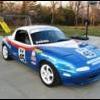
Test results from 1.6 header cleanup?
#61

 Posted 02-23-2016 07:15 PM
Posted 02-23-2016 07:15 PM

#62

 Posted 02-23-2016 07:20 PM
Posted 02-23-2016 07:20 PM

Just curious what a good TQ number is for a 1.6 ?
97ft/lb. And be happy with it.
CNJ
- Jim Drago and B(Kuch)Kucera45 like this


#63

 Posted 02-23-2016 07:29 PM
Posted 02-23-2016 07:29 PM

Haha97ft/lb. And be happy with it.
CNJ
I'm looking for an actual pro motor 1.6 TQ numbers to compare with mine to see if I'm above (


#64

 Posted 02-23-2016 07:31 PM
Posted 02-23-2016 07:31 PM

I actually have no idea. Probably too much
Seriously though, Jim posted TQ values for all engines he sells just a few days ago. I'm too lazy to go find his post.
CNJ


#65

 Posted 02-23-2016 07:55 PM
Posted 02-23-2016 07:55 PM

Just curious what a good TQ number is for a 1.6 ?
If doing at BackStreet ask Saul and Rich.



#66

 Posted 02-24-2016 12:38 AM
Posted 02-24-2016 12:38 AM

Hey Steve, so the shop (BSI Racing) did an initial dyno run with the car as was, then they cleaned up a manifold they had in shop, took the manifold off my car and cleaned it up and dyno'd both. The one on the car now posted the better result....with that being said, I don't know how the other cleaned up manifold performed.
OK. Not to be critical, nothing to be critical about, but so we have more information to include your experience can you tell me if he actually ran multiple runs first and tuned for a baseline? Was the drivetrain (trans and diff fluids) up to operating temps for each test, or were each of these quick single "cold" runs for comparison and not necessarily to compare with prior values? You mentioned similar results to Sean, on the same scale or just an improvement? Dyno charts?


#67

 Posted 02-24-2016 08:50 AM
Posted 02-24-2016 08:50 AM

OK. Not to be critical, nothing to be critical about, but so we have more information to include your experience can you tell me if he actually ran multiple runs first and tuned for a baseline? Was the drivetrain (trans and diff fluids) up to operating temps for each test, or were each of these quick single "cold" runs for comparison and not necessarily to compare with prior values? You mentioned similar results to Sean, on the same scale or just an improvement? Dyno charts?
Good morning Steve, I don't think the guys at BSI did that many runs or got that detailed - I specifically asked them to stay budget minded on the dyno time so the bill wouldn't be too crazy. I have the dyno chart from before the changes scanned into my computer, but the new dyno chart is in the trailer still, so I need to grab it over the next few days.
When I get them both in the computer I'll post them for you all to see if you can extract any worthwhile information out of them. I'm still learning all this stuff, so I'm not worth any real feedback other than lap times and how the car felt throughout the sessions.
#68

 Posted 02-24-2016 11:09 AM
Posted 02-24-2016 11:09 AM

better, worse or the same imo are almost meaningless unless you do dam near a full day of testing. small changes like diff, trans ,oil temps along with drum being warmed up are all potentially bigger changes than this modification. I have tested similar things and pulled what hair I have left out.. wasting a day and still not confident in my results. All these changes are within the margin of error of the dyno. So it can be a real task. IMO, the only true test of these type of changes is on an engine dyno with completely controlled conditions. We can get close,even give an educated opinion, but never a truly accurate one IMO.
- dstevens, trimless, Sean - MiataCage and 3 others like this
East Street Auto Parts
Jim@Eaststreet.com
800 700 9080













#69

 Posted 02-24-2016 07:18 PM
Posted 02-24-2016 07:18 PM

Would it be fair to say for a 1.6 that the header grind will result in a 0 - 2.5 peak HP improvement, your results may vary?




#70

 Posted 02-24-2016 09:12 PM
Posted 02-24-2016 09:12 PM

Would it be fair to say for a 1.6 that the header grind will result in a 0 - 2.5 peak HP improvement, your results may vary?
On an engine dyno
Could also potentially yield negative "measured" gains. Knowing how to dyno and read results is one of those things everyone should learn. There's lots to learn using the forums search tool (not directed at you, Tom).
I have an opinion so I must be right




#71

 Posted 02-24-2016 11:30 PM
Posted 02-24-2016 11:30 PM

It is harder to test that type of change than most really believe it is..
better, worse or the same imo are almost meaningless unless you do dam near a full day of testing. small changes like diff, trans ,oil temps along with drum being warmed up are all potentially bigger changes than this modification. I have tested similar things and pulled what hair I have left out.. wasting a day and still not confident in my results. All these changes are within the margin of error of the dyno. So it can be a real task. IMO, the only true test of these type of changes is on an engine dyno with completely controlled conditions. We can get close,even give an educated opinion, but never a truly accurate one IMO.
Agreed that it is more difficult than most believe, but not so much the rest depending on the chassis dyno and how it is used. Reliable and consistent results definitely require some experience, careful work and a lot more time than just strapping it down (or bolting it on) and doing a few pulls. And not all chassis dynos are created equal so your experience and mine are different. But it isn't by accident or chance that we can achieve the repeatability that we are seeing, and gains even half of what Sean listed would be clearly evident. So I come back to wondering why our particular engines are not responding to this modification. The most logical answer is that either our intake is limiting output so more exhaust flow makes little difference, or the exhaust is limited in other ways so removing the welds doesn't address the main restriction. I don't really buy either of those so I'm fishing for other explanations. I may try a straight pipe in place of the muffler just to see if that has any impact one way or the other. Perhaps I'll check with Sam Henry on his development of the SD system to see how it should respond.


1 user(s) are reading this topic
0 members, 1 guests, 0 anonymous users




 Sign In
Sign In Create Account
Create Account




 Back to top
Back to top Report
Report






